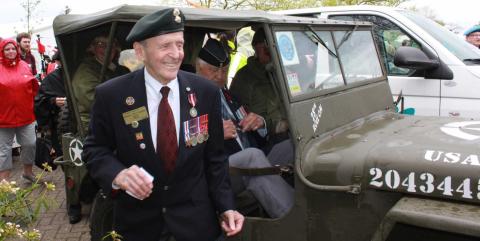
Shipping off
Gauthier made his way to England on the SS Le Pasteur. He recalled the ship being so crowded that he and his friends were packed in like sardines, sometimes even forced to sleep in stairwells. It was quite an introduction for someone who knew little about military life.
“There weren’t many soldiers in our family,” he said. “One of my uncles had been to the war in 1914, I believe, but aside from that, I wasn’t raised in the military, I didn’t know what the reality was, exactly.”
A chance meeting saves his life
Early in 1945, after his training in England, Gauthier was sent to Belgium. It was a harrowing arrival, with the plane circling two or three times before it could land. The runway had been bombed so the pilot had to come in on a makeshift airstrip made of metal sheets.
“It was my brother!”
From Belgium, Gauthier made his way to Nijmegen in the Netherlands. There, he had a chance encounter with his brother.
“In Nijmegen, they wanted to know if everyone was there and checked,” he recalled. “Then, all of a sudden, I noticed someone in the ranks—it was my brother!”
His brother gave him his helmet and boots, hoping they would bring him luck. The helmet certainly did: during Gauthier’s first battle, an explosion sent debris into his head. Thanks to the helmet, he came away unhurt. His brother’s gift had saved his life.
Liberation of the Netherlands
While moving through the Reichwald and Hochwald Forests, Gauthier and his unit came under attack from German forces. All he could see were tracer bullets flying past him. He said they also had to watch carefully for booby traps, as the Germans had hidden munitions underground. Though their engineers managed to discover and disarm most of the traps, Gauthier and the others still had to tread carefully. Two of Gauthier’s friends were wounded during these battles, and he never saw them again.
In the Netherlands, the terrain was difficult due to all the canals. Gauthier remembers crossing waterways in small sail boats. At one point, he found himself in the water with bullets flying by left and right.
As he and his unit continued to liberate the Netherlands, Gauthier remembers how hungry the Dutch people were. He specifically recalls young girls rummaging through the trash to find something to eat. He took it upon himself to ask the cook to save any food that would otherwise be thrown away, such as bully or corned beef—a meal that many soldiers did not enjoy—so he could give it to the young Dutch girls. He did the same with the unused clothes that the soldiers donated.
“Oh, they were just as happy.”
The war ends
Gauthier was in Oldenburg, Germany, when he heard the news that the War in Europe had ended. Everyone was so happy that even the Germans were celebrating. He remembers seeing a Canadian and German soldier riding a motorcycle together through the city, celebrating the end of the war.
“Oh, they were just as happy,” Gauthier recalled.
In honour of the 75th anniversary of the Liberation of the Netherlands and Victory in Europe Day (2019), Maurice Gauthier was a featured story. Sadly, he passed away in 2018.